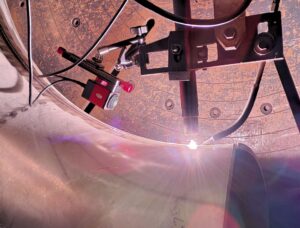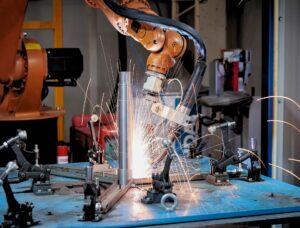Aluminum welding presents unique challenges compared to other metals due to its reflective surface, which can interfere with traditional arc monitoring methods. The high reflectivity of aluminum makes it difficult for welders to obtain accurate readings of the welding arc, often leading to poor weld quality, excessive spatter, and inconsistent results.In this blog, we’ll explore how welding cameras are revolutionizing Weld Arc Monitoring in Aluminum Welding, particularly in overcoming the difficulties posed by reflectivity. Let’s dive into how these innovative tools can improve arc monitoring, leading to better weld quality, efficiency, and safety.
1. The Reflectivity Challenge in Aluminum Welding
Aluminum’s high reflectivity can pose significant problems when it comes to arc monitoring and visual inspection. The welding arc can be obscured by the bright light reflection. This makes it difficult to accurately gauge parameters like heat input, arc length, and bead consistency. Without clear visibility, welders risk making adjustments based on incomplete information, which can compromise the integrity of the weld.
How It Affects Welding:
- Reflectivity of aluminum can distort visual feedback from traditional arc monitoring systems, leading to inaccurate assessments
- Overexposure to the welding arc’s intense light can cause visual fatigue and reduced precision in manual adjustments
- The reflected light can make it harder to detect weld defects like porosity, undercut, or improper bead formation
2. Welding Cameras: Enhancing Weld Arc Visibility in Aluminum Welding
Welding cameras are designed to overcome the challenges of weld arc monitoring in aluminum welding by providing high-quality visuals of the welding process, even in the presence of intense reflectivity. Advanced camera technologies, such as infrared and UV filters, can be used to filter out unwanted light while still capturing the crucial details of the welding arc and the weld pool.
How It Helps:
- Welding cameras equipped with specialized filters block out excessive light reflection, allowing operators to clearly see the arc and the surrounding area
- Use of infrared camera systems provides visibility in the heat zone, helping to track the heat distribution and prevent issues like overheating or burn-through
- Arc welding image quality is enhanced, offering precise visuals even under difficult conditions
3. Real-Time Feedback for Better Weld Quality Control
Real-time monitoring with welding cameras gives operators immediate access to the welding process, enabling them to make timely adjustments. With enhanced visibility of the arc, weld pool, and surrounding areas, welders can ensure that the aluminum welds are made with the proper heat input, consistent bead formation, and minimal spatter.
Benefits:
- Welding cameras allow for real-time monitoring of the welding arc, ensuring precise control over parameters like voltage, amperage, and travel speed
- Minimize spatter and excessive heat input, which are common issues when welding aluminum
- Instant visual feedback enables welders to adjust settings for optimal arc stability and weld pool control, ensuring a high-quality weld
4. Optimizing Welding Parameters for Aluminum
Aluminum is a highly heat-sensitive material, and improper control of welding parameters can lead to common problems such as warping, undercut, and excessive oxidation. Welding cameras help operators track the arc and weld pool in real time. This allows for quick adjustments to welding parameters to optimize the process.
How It Helps:
- Track the arc welding images to ensure that the heat input is consistent and controlled
- Adjust welding parameters such as travel speed, arc length, and wire feed speed to prevent overheating or inadequate fusion
- Use welding camera systems to fine-tune the settings based on visual feedback. This prevents common issues like burn-through or poor bead formation
5. Improved Detection of Weld Defects
Detecting defects during the welding process is essential, especially when working with aluminum, which can be prone to issues like porosity, slag inclusion, and cracking. Welding cameras provide operators with enhanced visual capabilities, making it easier to identify these defects as they occur, rather than discovering them after the weld has cooled.
Benefits:
- Welding cameras can detect weld defects like porosity or poor bead formation that may be difficult to spot with traditional inspection methods
- Operators can spot issues in real time and adjust their welding parameters to correct defects before they affect the integrity of the weld
- Welding visual inspection helps to monitor the heat input and bead consistency, ensuring that any anomalies are addressed immediately
6. Increased Efficiency and Reduced Rework
The ability to monitor the welding arc in real time with welding cameras leads to increased efficiency, as welders can make immediate corrections without having to stop the process for manual inspection. This reduces the need for post-weld repairs, minimizes rework, and speeds up the overall process, making aluminum welding more productive.
Efficiency Benefits:
- Real-time visual feedback allows operators to adjust welding parameters on the fly, preventing defects before they become major issues
- Welding camera systems help avoid unnecessary stoppages for manual inspections, keeping the welding process moving efficiently
- Reducing rework and improving first-pass weld quality leads to significant time and cost savings
7. Safety Benefits in Aluminum Welding
Welding aluminum can be hazardous due to the intense light and heat produced during the process. Welding cameras allow for remote monitoring, enabling operators to observe the welding arc and make adjustments from a safe distance, reducing the risks associated with exposure to intense UV light, heat, and fumes.
Safety Advantages:
- Remote monitoring with welding cameras minimizes the need for welders to be directly exposed to the intense heat and radiation
- Welding inspection from a distance reduces the risk of visual fatigue and eye strain caused by prolonged exposure to the arc
- Enhanced visibility improves overall safety by allowing operators to detect issues that may pose safety risks, such as excessive spatter or unanticipated weld pool movements
Conclusion: Overcoming Reflectivity Challenges with Welding Cameras
The reflectivity of aluminum poses a unique challenge in monitoring the welding arc and ensuring high-quality welds. However, by integrating welding cameras into the process, operators can overcome these challenges, providing real-time monitoring and enhanced visibility of the welding arc. This leads to improved weld quality, reduced defects, and increased efficiency.
Whether you are working in MIG welding, TIG welding, or plasma arc welding, welding cameras offer invaluable support in overcoming the challenges posed by aluminum’s reflectivity, ensuring that every weld meets the highest standards of quality and precision.
Mecaweld offers cutting-edge welding camera systems designed to enhance arc monitoring, improve weld quality, and optimize your aluminum welding processes. Contact us today to learn how our solutions can help you achieve superior results and overcome the challenges of aluminum welding.



